Overview
A survey was conducted with UVic students and instructors to better understand their experiences of learning and teaching within a predominantly online environment. The student survey was open between November 6-19, 2020 with the instructor survey occurring between October 29-November 18, 2020. The response was substantial with 5242 students (4744 undergraduate and 498 graduate), and 217 instructors participating (includes 113 faculty, 57 sessionals, 27 TAs plus instructional staff). All responses were anonymous and confidential.
The student survey was comprised of both quantitative and qualitative components, with the instructor survey focused entirely on open-ended questions. The completion rate for the surveys was high with approximately 80% of students and 90% of instructors completing all open-ended questions. The surveys were analyzed separately. After reading and reviewing the qualitative data, a coding process was undertaken. All data were coded and themes identified.
Student Survey (Quantitative)
Are you a new or returning student?
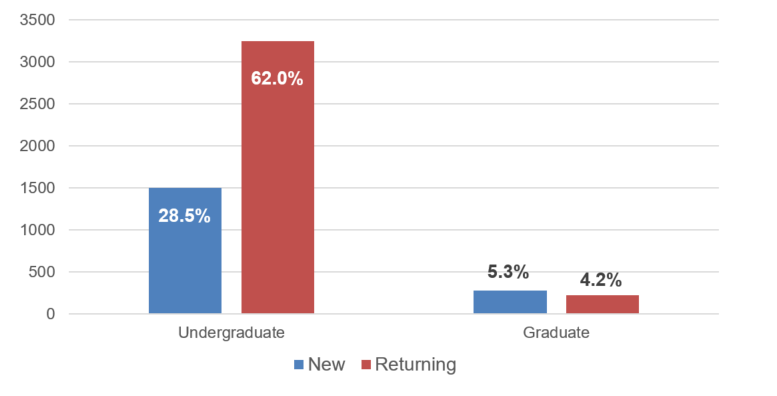
Do you identify as the following?
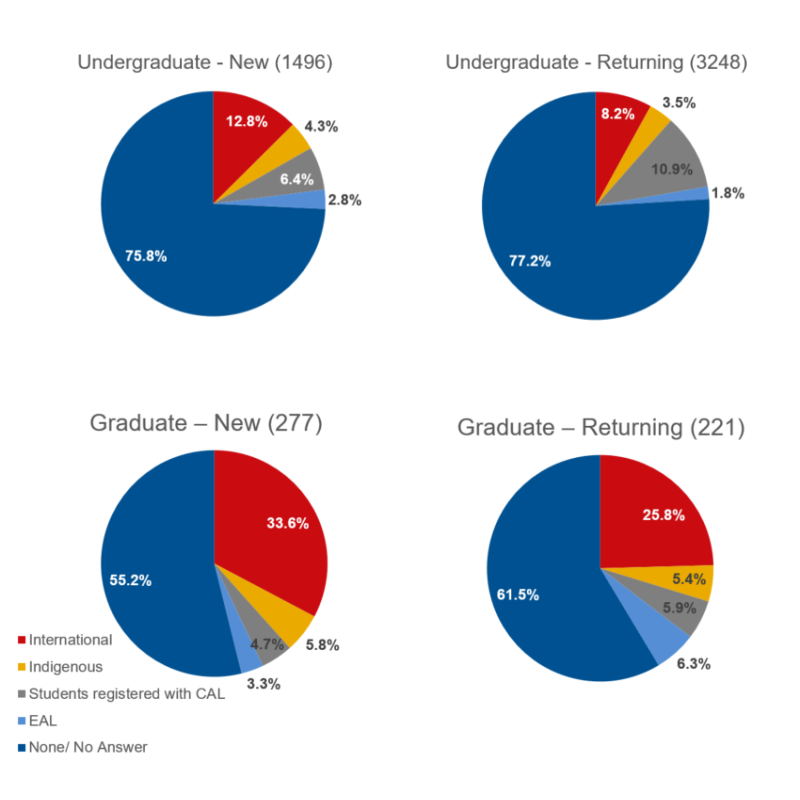
What is your workload this term
and average hours spent studying per course per week?
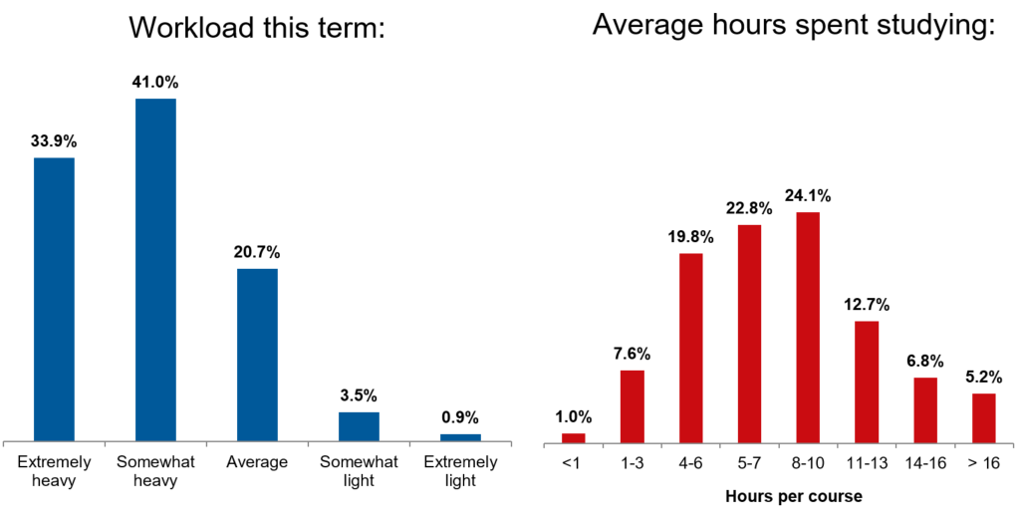
What barriers to accessibility have you experienced?
(Top five results)
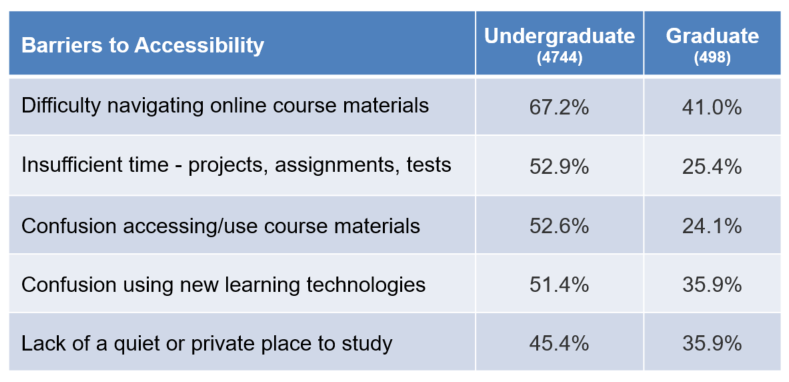
In what areas do you need additional support?
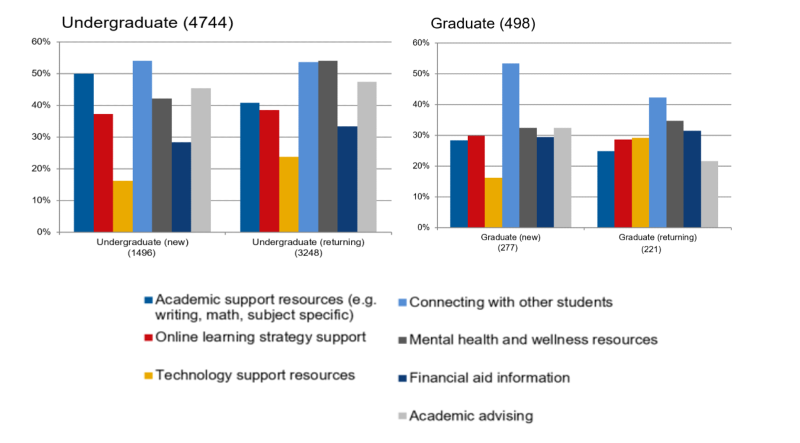
Instructor Survey

Convergent Themes from the Student and Instructor Survey
Analysis of the qualitative data was conducted separately in the student and instructor survey, however, it revealed a convergence between instructor and student survey responses. Within the analytic process five themes were identified. These themes are not mutually exclusive and intersect in significant ways. It is also important to note that while the themes identified significant concerns, there were also descriptions of effective learning and teaching practices and these strategies which were incorporated into the recommendations from the study.

Workload
Volume and Time | Assessments and Expectations
Moving to the online environment, both students and instructors reported being overwhelmed and fatigued by the sheer volume and magnitude of work. The volume of information (e.g. emails, posts, reading, and lectures) was described as being exhausting. More time than usual was required to prepare online classes and materials, to participate in the course, and to review and revise materials and assessment completion.
Students also described workload to be a challenge in terms of the number readings in place of lectures and of assessment activities (posts, discussion activities, assignments, tests/exams, etc.). In parallel, instructors described the significant work involved in grading ongoing assessments and some find grading in the online environment a challenge. For many (students and instructors), the expectations are perceived as being unrealistic and not sustainable.
Adapting to Online
New Environment and Technologies | Learning Curve and Preparation Time | Connectivity
Participants described the challenges of learning new technologies, experiencing a steep learning curve to the online format, fundamental differences from in-person learning and teaching, and having online fatigue from excess screen time. While overall there was a recognition of the value of new technologies available to support the transition, adapting to new technologies dramatically increased the amount of preparation required. These issues were sometimes conflated with connectivity, hardware and/or software difficulties. Some struggled with having adequate work or study space and many described a sense of isolation even when connectivity was achieved.
Other students and instructors described their experiences in a different way. They liked the new learning technologies including Brightspace, not having to commute, and having more control over their schedules. Some described the online environment as conducive to more flexibility managing their time, and described themselves as more focused and enjoying the term.
Course Quality
Impacted by Transition to Online Course Structure and Organization | Accessibility | Assessments |
Clear and Timely Communication
The transition to online has impacted the quality of instruction and of course offerings. Instructors proficient in teaching face-to-face reported struggling to teach effectively in the online environment. Students described high variability of quality among courses, influencing their ability to learn effectively. Courses structured with well-defined course outcomes, concepts, engagement strategies, and delivered in an effective format provided positive learning experiences. However, many students reported difficulty finding basic course content and activities, synchronous course sessions, and required assessments.
Accessibility requirements for those students with academic accommodations, from both the student and instructor perspective, were described as challenging. For students, previous accommodations did not translate smoothly to the online environment. For instructors, planning and providing the necessary additional supports for students with academic accommodations was described as challenging when teaching in an online context (i.e. timed exams and managing the volume of accommodations in larger classes).
Engaged Learning Experiences
Critical to Online Learning | Presence and Opportunities to Connect | Clear Consistent Communication
Connecting and engaging in the learning process is important. It is even more critical in an online learning environment, compared to face-to-face. Student and instructor respondents described repeatedly the value, importance, and challenge of engaged learning in an online course. Students described missing the ongoing presence of the instructor, whereas instructors shared frustration of not being able to connect better with students. Students also described the loss of opportunities to connect with other students. For students, the loss of the social aspects of the “on campus” university experience was substantial.
The importance of clear, timely, and consistent communication was an unwavering request from students. This included both informal opportunities for dialogue (such as instructor availability for a few minutes before or after a synchronous Zoom session) and formal opportunities (such as assignment instructions or an instructor regularly engaging in discussion posts). There were also many calls for opportunities for students to engage with one another within the classroom context and beyond.
Mental and Physical Health & Wellbeing
Awareness and Compassion | Access and Knowledge of Existing Resources | Additional Resources
Concerns about the mental and physical health and well-being of students and instructors permeated the participant responses. Participants voiced a need for increased awareness of and compassion for the isolation and mental health challenges that are being experienced. While some respondents did acknowledge positive experiences with online learning, many described a sense isolation. Both students and instructors expressed the need for more awareness of mental health challenges. These results remind us that in these unusual times, people are stressed/anxious and needing easy access to a wide range of resources and supports.
Pandemic Context
The pandemic context is the underlying backdrop for the five themes. It is hard to overstate the profound task that instructors and students have had over the past months. Transitioning to the online environment has included the need to introduce new learning technologies (including a new LMS), adapting to learning and teaching online (which is fundamentally different than face-to-face), and for some, broader economic, housing, family, or care-giving challenges. While some managed well over the recent months, the pandemic context was evident throughout the data with many describing one of their most challenging years.
Recommendations & Resources
For many instructors and students, the Fall 2020 term was their first experience with online learning and teaching. Not surprisingly, turning quickly to online instruction during a pandemic posed many challenges and those are evident in the findings. It is also important to recognize that instructors and students alike, having learned from this first-hand experience this fall, will proceed into spring term with a new set of knowledge and greater confidence in how to approach online learning and teaching.
The seven recommendations are drawn directly from the findings of both the student and instructor surveys (ie. suggestions for improvement and support). The first four recommendations are instructor-focused strategies. Acknowledging that the online environment has impacted workload, these recommendations are intended to make learning and teaching more manageable for both students and instructors. The last three recommendations focus on broad university strategies that culminate in creating a more robust communication and navigation strategy for students and instructors.
1. Clear, concise and consistent communications and expectations
The importance of clear, timely, consistent communication was an unwavering request from students.
1. A clearly identified course syllabus is required for every course. Students need to know up front what the expectations are for the course, including any synchronous commitments. Other strategies are included in our guidelines:
< See syllabus guidelines in the Spring 2021 Guide >
2. Include clear expectations of all assessment components (i.e., weighting and priorities) and delivery methods of the assessments (synchronous, asynchronous, etc.) within the syllabus.
3. Set course workload expectations recognizing that your course is just one of 4-5 courses being taken. Students can expect to spend approximately 8 – 10 hour per course per week.
4. Provide students with an orientation to the course and course site within the first week of term. Instructors can request to have a Learning Technology Assistant attend the class and support the orientation and/or provide a Brightspace orientation at the same time.
< Request support using our TIL Request Form >
5. Review all letters for students with academic accommodations at the start of the course to identify and plan for necessary supports.
< Submit an accommodation request to have LTSI set up and discuss options for online accommodation >
6. Survey your class early in the term to identify additional accessibility issues including alternate time zones, access to technology and challenges in having an uninterrupted space to engage in synchronous sessions.
7. Provide a weekly overview of expectations in the course as a guideline for students.
8. Integrate regular opportunities for student feedback in the course by adding a mid-course feedback survey.
< How to add a mid-course feedback survey to your course >
9. Maintain a continued and predictable presence in the course so students are assured they have a regularly available avenue to connect with the instructor.
2. Focus on the essentials
This is critical to managing both your and your students’ workload. Be selective in the activities you choose to incorporate into the course. It is important to reduce any peripheral content, learning activities or assessments, keeping in mind that focusing on essentials needs to be balanced with meaningful engagement.
1. Keep courses as streamlined as possible – focusing on core learning outcomes, critical readings, and essential assessments, while retaining meaningful opportunities for student engagement.
< How to streamline your course >
2. Review your final assessments keeping in mind that the formal exam period in April is shorter due to the delayed start of term. Wherever possible use alternative exam formats (e.g. flexible start times, multi-day open book) to reduce the likelihood of students having multiple timed exams on one day.
3. Create a culture of academic integrity by reviewing with students at the beginning of the course, and intermittently throughout, your expectations and University standards for academic integrity. Remind students of the expectation that all students abide by UVic Academic Integrity regulations by integrating a pledge into all online exams and assessment activities. If you plan to use Zoom invigilation or Respondus, notify your students in advance, preferably in the syllabus.
< Review: effective teaching and assessment practices to promote academic integrity >
4. Provide more than adequate time for students to complete any assessments, including exams, recognizing that students often find the online exam environment stressful and some students may experience technical difficulties. Exams should provide a fair opportunity for students to demonstrate learning.
5. Assessments should be distributed across the term but not create excessive workload. Feedback focused on the beginning part of term will promote learning.
< Read Taylor’s Assessment Model (2008) >
6. Consider assessing engagement rather than participation alone.
3. Course structure and organization
Students benefit from consistent course structure and a well-organized course.
1. Consider using the fully customizable Brightspace template, a pre-stocked resource that includes specific tools (feedback surveys, quiz formats etc.)
< Access the Brightspace template >
2. Organize your course by weeks or key concepts/topics as opposed to delivery format (lectures, readings or videos).
3. Provide a weekly update for students to recap the past week and highlight upcoming important activities or assessments.
< How to post weekly updates or introductions in Brightspace using announcements or activity feed >
4. Remain within the scheduled time for synchronous sessions (50 minutes for one-hour time slot and 80 minutes for 1.5-hour time slot). Synchronous sessions are to be scheduled only as they appear in the timetable. Instructors may require asynchronous activities in place of synchronous sessions that require relatively the same time commitment.
5. Recognize that students and instructors alike require unscheduled time. Respect the Reading Break closure.
4. Accessibility and flexibility
Accessibility and flexibility are important factors within the online environment. Students have varying needs (access, time zones, living situations) especially within the pandemic context. It is also important to address the requirements for students with approved academic accommodations.
1. To maximize accessibility and flexibility, use the principles of universal design for learning (UDL) in your course. These include such strategies as: flexible exam start times, alternate forms of assessment, multimedia approaches and offering options for how students can demonstrate their knowledge. Providing flexibility enables a greater level of accessibility for all students.
< Read Key Questions to Consider When Planning Lessons (CAST) >
< Read the Universal Design for Learning Guidelines (CAST) >
2. Closed captioning is automatically provided for all posted videos through Kaltura. Allow students to access and review videos throughout the course to enhance their learning.
3. When designing assessments, review for accessibility and flexibility. Carefully consider the range of accessibility barriers that students may experience in the context of the pandemic.
4. Make course materials and resources available for the full length of the term wherever possible. Use start/end date restrictions only in situations where absolutely necessary.
5. Seek supports from the Centre for Accessible Learning (CAL) and LTSI for specific questions on accommodation requirements for students with approved academic accommodations. UVic has recently added two Learning Experience Designers – Accessibility to augment supports for instructors in addressing the needs of students with academic accommodations.
< Request instructor support for exam accommodation >
6. Ensure International students living in different time zones can access office hours by providing an alternative when necessary. Wherever possible provide course materials asynchronously as needed.
7. Students and instructors alike point to the importance of approaching student questions and concerns with compassion, recognizing students and instructors may be facing a variety of challenges related to the pandemic.
5. Engagement, interaction and connection
Creating a learning community within your course is critical to success in online learning. Students report needing to connect informally and formally with instructors and with other students in their courses.
1. Encourage students to maintain a presence in the course (video, chat, other forms of communication), recognizing that some students may not be able to or are uncomfortable with keeping their cameras on.
2. Promote a respectful class culture by setting class expectations for engagement and participation.
3. Include opportunities for students to interact with one another within the context of the course (synchronous or asynchronous activities and discussion). Encourage students to set up study groups to facilitate connections beyond the class.
3. Intentionally create opportunities for formal and informal contact where students can interact with you as an instructor (formal: office hours, discussion posts; informal: being available on zoom just before and after the session).
4. Foster contact between your TA and students as appropriate.
5. Encourage students to take advantage of other university resources which can also help students build a sense of connection and community.
< Promote Learn Anywhere as a portal for student resources >
6. Mental and physical health and wellbeing
Mental and physical health and wellbeing are widely reported as being negatively impacted by the pandemic environment. This is reflected in the findings from the student and instructor surveys. Often students seem unaware of the range of resources that are available. There are small but important strategies you can incorporate into your course to support student wellbeing.
1. Build virtual connections between students, remembering that some students may be living in different time zones – reducing social isolation is key during this time.
< Explore online communities on Learn Anywhere >
2. Start and stop any synchronous sessions on time, and encourage students take regular breaks from the online environment to reduce fatigue.
< Read: Five ways to alleviate burnout and stress during uncertain times >
3. Remind students to get up and move between classes – intermittent physical activity is important to their mental and physical health. Even stepping outside for a few short minutes can make a substantial difference for students.
4. Encourage students to take breaks from schoolwork to enjoy other fun activities and connect virtually with their peers in a non-academic setting.
5. Openly acknowledge the importance of mental health and the social isolation challenges that may be occurring within the context of the pandemic.
6. Encourage students to reach out and access resources if they need support, reminding them they don’t need to be in a crisis to seek help. Access Support Connect is a resource for students to access mental health support 24/7 and is available worldwide, regardless of time zone or location. It is a also a good resource for instructors seeking advice on supporting students’ mental health.
< Access Support Connect: Free 24/7 online mental health support >
7. Instructors may also be experiencing mental health challenges. The Employee & Family Assistance Program (EFAP) is available for all UVic instructors, staff and dependents.
7. Navigation and access to resources and supports
This recommendation relates directly to ensuring that communications are clear, consistent, coordinated and foster improved navigation. Many of the resources requested by students and instructors in the survey responses already exist. This leads us to recognize that the primary challenges is increasing awareness of the available resources and being able to locate the right resources at the right time.
1. The primary resource for student supports is Learn Anywhere where students can access a full range of resources including:
< Counselling and Mental Health Supports >
2. Instructors can access supports and a wide range of resources through Teach Anywhere such as:
View the full report
Findings from the student and instructor surveys in detail are listed in the following working report. Please note that more subanalysis will be available on certain student groups in the near future.
